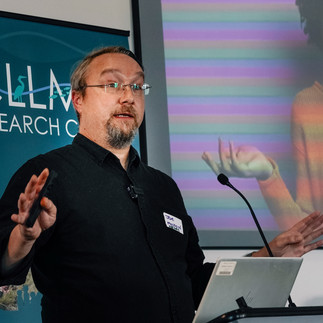Updated: 3 days ago
Professor Sabine Dittmann and her team from Flinders University worked together with Burrandies Aboriginal Corporation, Leed Construction, DEW and the Limestone Coast Landscape Board on a local site being cleared for wetland restoration. This is a unique opportunity for field work by the blue and teal carbon research team to measure, weigh and 3D scan vegetation of different size and age for its carbon storage potential.
# blue carbon is carbon stored in coastal and marine ecosystems.
# teal carbon is carbon stored in freshwater and wetland ecosystems.
Two new Honours projects starting with the CLLMM Research Centre
We are committed to nurturing the next generation of researchers and have started two new Honours student projects:
‘Assessing the psychological benefits of community directed science engagement’
Student Andrew Persian (UniSA) is being supervised by Elissa Pearson (UniSA) and Bri Le Busque (UniSA)
‘Behaviour and habitat use of Rakali (Hydromys chrysogaster/ Native Water Rat),Goolwa’.
Student Hannah McKennall from Flinders University is being supervised by Ryan Baring (Flinders University), Gilad Bino (UNSW) and Tahneal Hawke (UNSW)
Updated: 3 days ago
In celebration of International Women's Day, we highlighted the work of five remarkable CLLMM women researchers. Three of them are featured here:
Updated: 3 days ago
Bringing our project teams together in the CLLMM
A major event for the Research Centre brought together project teams for our first Research Networking Day.
On Friday 28th February 2025, we met in person to connect with each other and the Coorong region, sharing knowledge of our specific work and how we collectively are building a body of knowledge to help the region respond to the challenges facing it.
Rebekha Sharkie MP, who recently tabled the CLLMM Annual Report in Federal Parliament, placing on record the value of our research to the region, officially opened the event with a call for more scientific contributions in public discussions.
“We need more science, we need more scientists in Parliament House,” she said.
We were joined by representatives from First Nations and other local community organisations, sharing their perspectives of collaborating with the Centre, as well as management insight into how CLLMM research is perceived.
Dr Joe Milton from the Science Media Centre led a session making science more accessible to wider audiences:
using media opportunities to explain what we are investigating
how to create messages for people with some/little/ no prior knowledge
using images and video to help the ‘picture tell the story.’
A First Nations panel led by CLLMM’s First Nations Engagement Officer Kyla McHughes discussed topics including cultural protocols, clearances for onsite work and building relationships with the local community.
The final workshop session was all about conveying future climates. Guided by presentations from Kerri Muller (AU2100), Ryan Lewis (DEW), Mike Dunlop (CSIRO) and Matt Gibbs (CSIRO), project teams were tasked with exploring how to share and benefit from existing resources and tools (climate change scenarios and climate modeling) and developing personal networks for future collaboration.
It was a rewarding day which created an opportunity to meet, share and learn together. We will definitely do it again!

















